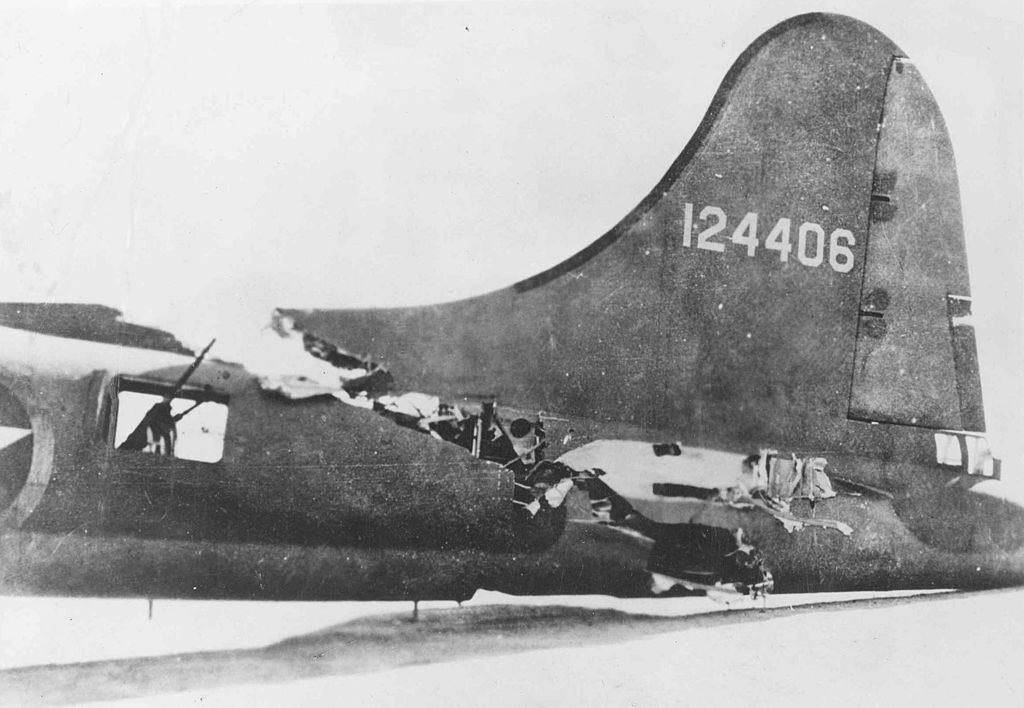The tail section of the All American fuselage was saved by a few thin spars and a thin strip of metal skin after the Me 109’s wing nearly cut through it
The amazing photographs in this article, which were taken on February 1, 1943, show B-17F-5-BO, serial number 41-24406, “All American,” still flying despite being hit by a Luftwaffe Messerschmitt Me 109.
On August 24, 1942, the 414th Bomb Squadron, 97th Bomb Group, received the aircraft All American, which was assigned to Lt. Kendrick R. Bragg and the crew. Major Robert Coulter commanded the 97th BG bombers as they departed from their base in Biskra, Algeria, on February 1st, 1943, in order to target the Tunisian and Algerian ports that the Germans had taken possession of.
Prior to takeoff, one of his scheduled wingmen experienced engine issues, so All American, a “Spare,” filled in.
German Messerschmitt Me 109 fighters attacked the bombers after they had dropped their bomb load and returned to base. The lead B-17 and the All American, which were both flying in formation, were both attacked by two fighters. The first fighter was taken out by the bombers’ machine guns, but the second continued to attack the All American head-on.
Pride of Seattle, The Story of the First 300 B-17Fs by Steve Birdsall claims that what transpired next left the troops in front of the airplane with lasting recollections. “I was firing at it all the way… I figure one of us must have killed the pilot because the plane crashed right into us… When we hit, our plane almost stood up on its tail. Then we went down at a very sharp angle. I thought to myself, ‘boy, this is it’.” Bombardier Lt. Ralph Burbridge remembers.

Navigator Lt. Harry Nuessle said, “About 300 yards out [the fighter] began to roll over in order to be able to pull down and away after his attack – but somewhere about halfway around, either Burbridge’s fire or fire from the lead ship must have gotten the pilot or disabled the plane because he never completed his intended roll and rapid pass under our ship – for one horrible instant he was right there inches in front and above us – I ducked instinctively, though God knows had he hit us head-on [then] no amount of ducking would have saved any of us. But he passed over us with distinctly audible swoosh followed by a tremendous jar and whoomp! Our plane began to dive, and I reached for my ‘chute.”
Brag recalls, ” I rammed the controls forward in a violent attempt to avoid collision… I flinched as the fighter passed inches over my head and then I felt a slight thud like a coughing engine. I checked the engines and controls. The trim tabs were not working. I tried to level All American, but she insisted on climbing. It was only by the pressure from knees and hands that I was able to hold her in anything like a straight line.” As explained by Birdsall, co-pilot Lt Godfrey Engel tried his controls with the same result, but the pilots found that by throttling back the engines, they could keep her “on a fairly even keel.”
Erich Paczia of I/Jagdgeschwader 53, a 16-victory ace, was said to be the Me 109’s pilot. The Me 109’s wing nearly tore through the B-17’s fuselage, leaving the tail section hanging on by a few thin spars and a thin strip of metal skin.
However, Bragg and his team made the decision to attempt to return All American to their homeland.
“As we neared the field we fired three emergency flares, then we circled at 2000 feet while the other planes in our formation made their landings and cleared the runways… I lowered the landing gear and flaps to test the reaction of All American. They seemed to go reasonably well, considering,” Explains Bragg. “I made a long careful approach to the strip with partial power until the front wheels touched the leveled earth and I could feel the grating as she dragged without a tail wheel along the desert sands. She came to a stop and I ordered the co-pilot to cut the engines. We were home.”
The All American was fixed and sent back into service, but because of her problematic flying characteristics, she was operated as a utility aircraft until she was found in another country in March 1945.
The following video with All American story offers some interesting images of the damaged B-17 after it had safely returned to base.
Photo by U.S. Air Force

